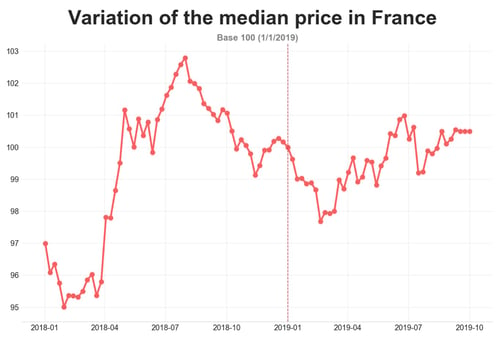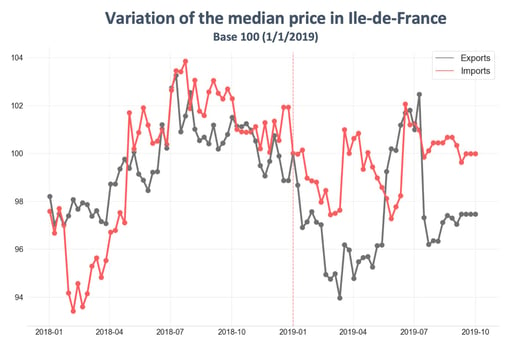
According to the Upply database the price of road freight transport in France has been on the rise again during the month of September, up by 0.5% compared to August. The price curves for 2018 and 2019 have crossed over which suggests a small inflationary sequence for the end of the year.
1/ The transport market on a national level
The linear rise in prices that has already been seen over 2019 has continued into September (+ 0.5% compared to August).

Source: Upply
The market has been driven by several different factors:
- The healthy state of the French economy: The Business Climate indicator stands at 106.2 (+ 0.9% compared to the previous month)
- A lack of transport capacity
- A definite understanding by shippers of the problems facing their providers. This means that price increases that are in line with those of costs are more readily accepted this year compared to previous years, if the declarations of certain carriers during the FNTR conference on the 26th of September are anything to go by.
The impact of the drop in diesel prices during the previous month does not seem to have affected the transport price inflation in September. The international tensions in the Persian Gulf may have already been taken into account…the price of diesel is also taking on an upward trend!
2/ Focus on the Ile-de-France region
Let us take a more in-depth look at import/export activity for France’s largest region: more than 50% of France’s traffic flow leaves from or arrives in Ile-de-France.
The following table shows price variations in the Ile-de-France region. It is striking to note that the curves have the same form as those for the whole of France. The area around Paris is also the country’s barycentre in transport terms.

Source: Upply
The volumes exported are more or less identical to those imported. There is, however, a slight difference in the mileage costs: 1.53€/km for exports compared to 1.47€/km for imports. This difference comes mainly from the geographical mix of traffic flows: the import-export balance is positive from the regions in Northern France heading towards the South because the cost of transport in the Northern regions is lower than elsewhere owing to the competition from carriers operating down from Belgium and Germany.
However, the difference between the two curves is much more apparent in 2019 than in 2018.
Owing to the continuing strong activity in the Northern regions, the price market tends to be much more resilient for imports. The export market, however, almost certainly suffers from a lower level of consumer spending in the Southern regions and a downward pressure on returns towards the North and Germany.
THE PRINCIPAL MARKET INDICATORS

Source : Insee, CNR

Our latest articles
-
3 min 08/01/2026Lire l'article
-
Subscriber France: Road transport prices remain stagnant in November
Lire l'article -
Container shipping in 2025
Lire l'article


